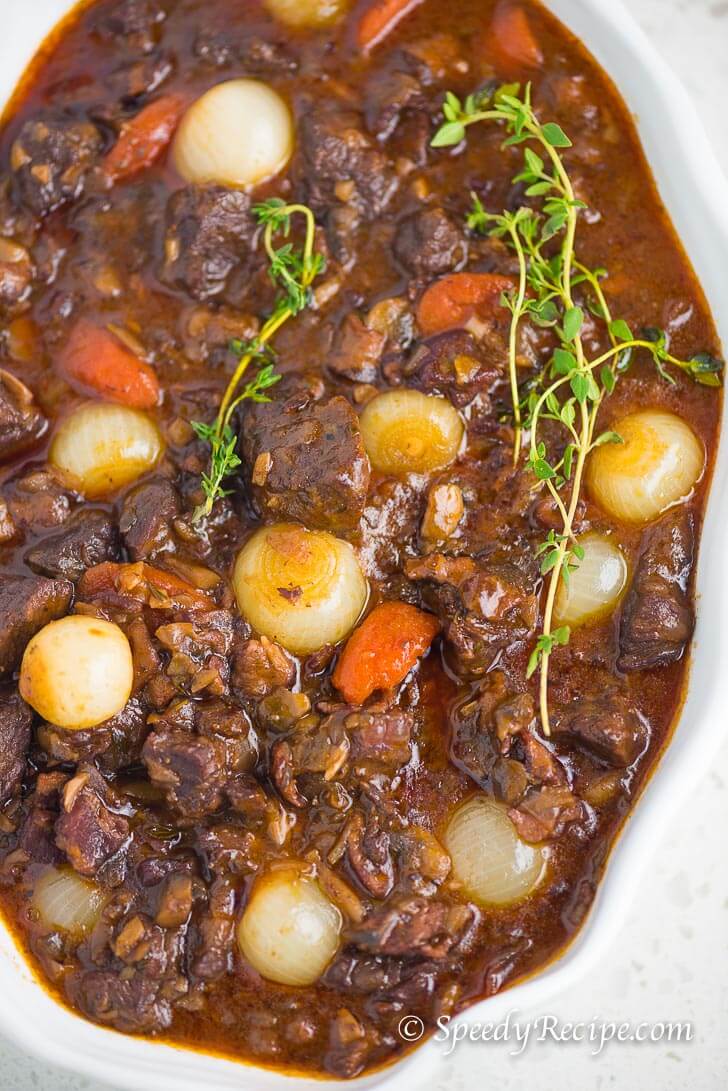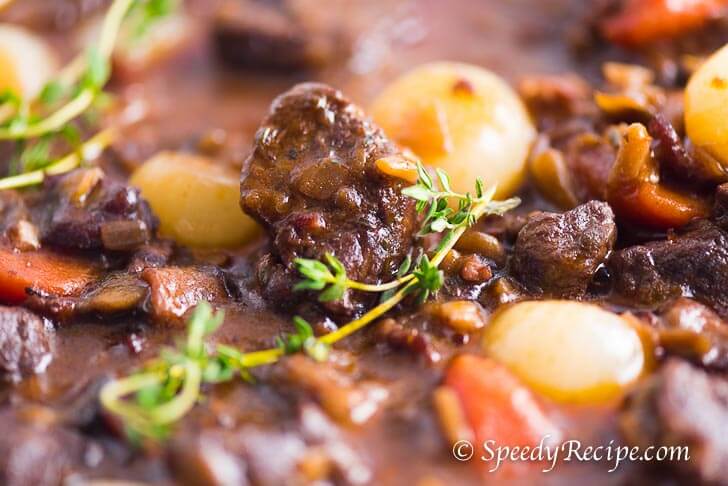In France, Beef Bourguignon holds its spot as one of the most well-loved comfort dishes. You’ll find it served in countryside homes on weekends or brought to the table during cooler months when slow-cooked stews take over. The dish usually comes out during family lunches, paired with crusty bread and a bottle of red.

Personally, I like how it turns a tough cut of beef into something that feels thoughtful without taking too much out of your day. I usually have it with mashed potatoes, and if I have guests, I serve it with a small salad and a light red. The recipe moves at a steady pace without needing constant attention, which is always a plus when you’re managing a few things at once.
This version sticks close to the traditional approach but adjusts the timing to favor home kitchens. The pearl onions don’t overpower anything, and the mushrooms hold their own in the mix. Instead of piling on heavy seasoning, the balance comes from the slow cook and simple ingredients.
What is Beef Bourguignon?
Beef Bourguignon, also called “Boeuf Bourguignon,” is a slow-cooked French beef stew braised in red wine, usually from Burgundy. The name itself comes from the Burgundy region and points directly to both the beef and the wine used in the dish. Over time, it became a symbol of old-school French home cooking.
This stew stays popular in France because it honors basic ingredients through slow cooking, which softens and strengthens flavor without much fuss. Back in the early 20th century, it was considered peasant food. But once chefs began serving polished versions in restaurants, it reached broader audiences. There’s also some debate about whether the traditional wine used must be Burgundy, though many home cooks now use Merlot or Pinot Noir instead.
French housewives often cooked it a day in advance since the flavors deepened overnight. That habit still carries over today in recipes that suggest making it ahead for better taste. The pearl onions might seem like a small detail, but they help break up the richness with soft sweetness. You’ll also notice that this dish rarely uses garlic, which sets it apart from other slow-cooked European stews.

Ingredients of Beef Bourguignon
Main Proteins
- Beef chuck or sirloin (2 lbs.)
This is the heart of the stew. Chuck works better than sirloin for long cooking because it breaks down nicely and gives off richer flavor. - Bacon (6 ounces, chopped)
Bacon adds depth and gives the stew a strong foundation of flavor. I usually cook it until just lightly crisp to avoid overpowering everything else.
Vegetables and Aromatics
- Carrots (2 medium, sliced diagonally)
Carrots give off a light sweetness that softens the wine’s edge. Cutting them on a diagonal helps them hold their shape during the long cook. - Yellow onion (1 medium, diced)
This adds roundness and helps form the stew base. I cook it just until soft to keep the profile gentle. - Pearl onions (12 to 18 pieces, peeled)
These stay whole and offer a soft pop with each bite. I soak them in warm water for five minutes before peeling to loosen the skins. - Fresh thyme (1 ½ tablespoons, chopped)
It adds a light herbal note. I use fresh instead of dried since it holds better during long cooking without going bitter.
Liquids and Base Flavor
- Red wine (3 cups, Merlot)
This gives the stew its identity. Merlot has soft edges and a mellow body that braises the beef evenly without tasting sharp. - Beef broth (2 cups)
It complements the wine and keeps the stew from becoming too acidic. Keep extra on standby to prevent the pot from drying out during the simmer. - Tomato paste (2 tablespoons)
This enriches the sauce with mild acidity and a deeper color. I stir it in before simmering to let it melt into the mix.
Mushrooms and Finishing Touches
- Cremini mushrooms (¾ lb., chopped)
They bring in a deep earthy note and soak up all the good bits from the butter. I cook them in a separate pan to keep them firm. - Butter (3 tablespoons)
Used only for the mushrooms. Melt it over medium heat just enough to coat, not brown. - Flour (2 tablespoons)
This thickens the stew slightly near the end. I sprinkle it gradually and stir fast so it blends in smoothly. - Salt and ground black pepper (to taste)
Add this last. I always taste the stew once the broth and wine reduce since the salt from bacon and stock builds over time.

How This Beef Bourguignon Stands Out
Most versions of Beef Bourguignon online either rush the wine reduction or drown the meat in too much liquid. I hold back on both. The wine in this version gets just enough time to cook down before the broth comes in, which helps the stew taste fuller without becoming sharp or watery.
Another common mistake I’ve seen is skipping the separate step for the mushrooms. Adding them straight into the pot early on makes them soggy and dull. Here, I sauté them in butter on the side and add them near the end, which keeps their flavor focused and their bite intact. Also, I avoid overly processed additions like bouillon cubes or powdered seasonings. The tomato paste, red wine, and beef broth already carry everything the sauce needs when you let them simmer slow and low.
Compared to traditional French recipes, this version makes the prep more manageable without losing that long-cooked feel. It stays close to its roots by not trying to modernize every element, but it skips the multi-day prep many classic methods require.
Now that you know what sets this one apart, let’s go into the actual cooking. This step-by-step breakdown I wrote keeps things clean and doable, even if you’re short on kitchen space.
How to Cook Beef Bourguignon
- Render the bacon first – Cook the chopped bacon in a large pot over medium heat until the fat releases and the pieces turn light brown. Remove the bacon and transfer it to a bowl, then scoop out half the fat and set that aside too. This step builds the base flavor and gives you just the right amount of fat to sear the beef.
- Sear the beef in batches – In the same pot, use the remaining bacon fat to brown the beef cubes. Let them cook for 5 to 8 minutes until all sides are medium brown. Stir occasionally, but give the pieces space so they don’t steam. Once done, transfer both the beef and its juices to the bowl with the bacon.
- Build the vegetable base – Pour back the reserved bacon fat into the pot. Add sliced carrots first and sauté for about 3 minutes. Stir in the diced yellow onion and cook until it softens without browning too much. This mix will catch the fond from the meat and bring all the flavors together.
- Deglaze and simmer – Return the beef and bacon mixture to the pot with the vegetables. Pour in the red wine and beef broth, and stir well to loosen any bits stuck at the bottom. Add tomato paste and chopped thyme, then cover the pot and reduce the heat to low. Let it simmer gently for 2 hours. You can add a bit more broth if the stew starts to look dry.
- Sauté the mushrooms separately – While the stew simmers, melt butter in a separate pan over medium heat. Add the chopped mushrooms and cook for 3 to 4 minutes until they darken slightly and soak up the butter. Set them aside and don’t stir them into the stew yet.
- Add the pearl onions and mushrooms – After the stew has simmered for 2 hours, drop in the peeled pearl onions and cook for another 8 minutes. Then fold in the sautéed mushrooms with all their butter. Stir gently so everything mixes without breaking down the onions.
- Finish with flour and adjust seasoning – Sprinkle the flour across the top of the stew. Stir immediately and keep going until the flour dissolves fully into the sauce. This will thicken it slightly. Taste and adjust with salt and pepper
What to Have with Beef Bourguignon
I enjoy Beef Bourguignon with mashed potatoes because the wine-rich sauce sinks into every spoonful. Sometimes I serve it with a light salad on the side, but the stew already holds enough weight to carry a meal on its own. When I want something traditional, I go with a French pairing, it always feels complete.
- Mashed Potatoes – This is the most classic side in French homes for stews like this one. The mash soaks up the sauce and supports the tender beef without fighting the flavors.
- Baguette or Country Bread – A torn piece of crusty bread handles the sauce better than utensils sometimes do. In France, it’s common to clean your plate with bread, especially when the sauce is this rich. You can toast it lightly for texture, but it works fine as is.
- Green Beans Almondine – This light side dish balances the richness with a soft crunch. Green beans are cooked quickly and tossed with butter and slivered almonds, giving the plate some contrast without pulling focus. You’ll often see this served during holidays with braised meats.
- Buttered Egg Noodles – In Eastern France, egg noodles appear alongside stews like this when potatoes aren’t available. They’re soft, neutral, and coat well with sauce. If you want a simpler starch than mash, this works better than rice. Try egg drop ramen if you want something warm with beef bourguignon.
- Ratatouille – Though it’s from southern France, ratatouille often shows up next to meat-based dishes during fall and winter. It uses eggplant, zucchini, and tomato for a light vegetable contrast. If you want a French-style veg that doesn’t lean too sweet, this fits well.
Beef Bourguignon gives you space to build the plate how you want. If you prefer soft sides, mashed or noodles work best. If you lean toward texture, bread or green beans will round things out. I’ve served it both ways, and it always holds its own no matter what’s beside it.







Leave a Reply